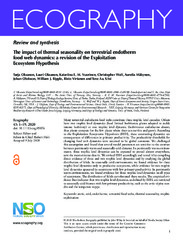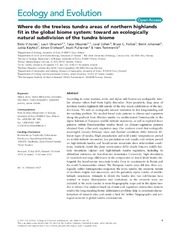Browsing by Author "Oksanen, Tarja Maarit"
-
The impact of thermal seasonality on terrestrial endotherm food web dynamics: a revision of the Exploitation Ecosystem Hypothesis
Oksanen, Tarja Maarit; Oksanen, Lauri; Vuorinen, Katariina; Wolf, Christopher; Mäkynen, Aurelia; Olofsson, Johan; Ripple, William J.; Virtanen, Risto; Utsi, Tove Aagnes (Journal article; Tidsskriftartikkel; Peer reviewed, 2020-09-06)Many terrestrial endotherm food webs constitute three trophic level cascades. Others have two trophic level dynamics (food limited herbivores; plants adapted to tackle intense herbivory) or one trophic level dynamic (herbivorous endotherms absent, thus plants compete for the few places where they can survive and grow). According to the Exploitation Ecosystems Hypothesis (EEH), these contrasting ... -
Macroecological patterns of rodent population dynamics shaped by bioclimatic gradients
Soininen, Eeva M; Magnusson, Magnus; Jepsen, Jane Uhd; Eide, Nina Elisabeth; Yoccoz, Nigel Gilles; Angerbjörn, Anders; Breisjøberget, Jo Inge; Ecke, Frauke; Ehrich, Dorothee; Framstad, Erik; Henttonen, Heikki; Hörnfeldt, Birger; Killengreen, Siw Turid; Olofsson, Johan; Oksanen, Lauri; Oksanen, Tarja Maarit; Tveito, Ole Einar Ellingbø (Journal article; Tidsskriftartikkel; Peer reviewed, 2024-12-27)Long-term studies of cyclic rodent populations have contributed fundamentally to the development of population ecology. Pioneering rodent studies have shown macroecological patterns of population dynamics in relation to latitude and have inspired similar studies in several other taxa. Nevertheless, such studies have not been able to disentangle the role of different environmental variables in shaping ... -
The paradox of searching efficiency or why are violent population cycles so uncommon in terrestrial ecosystem
Oksanen, Lauri; Vuorinen, Katariina Elsa M; Oksanen, Tarja Maarit (Journal article; Tidsskriftartikkel; Peer reviewed, 2023-04-19)The searching efficiency of predators depends on the balance between the adaptations of the predator and the counter-adaptations of the prey. In this evolutionary race, the prey should normally have the upper hand, as it can perform tradeoffs between efficiency in resource use and ability to avoid predators. In terrestrial predator–herbivore systems, however, the huge difference in food quality ... -
Taking the beat of the Arctic: are lemming population cycles changing due to winter climate?
Gauthier, Gilles; Ehrich, Dorothee; Belke-Brea, Maria; Dominé, Florent; Alisauskas, Ray; Clark, Karin; Ecke, Frauke; Eide, Nina Elisabeth; Framstad, Erik; Frandsen, Jay; Gilg, Olivier; Henttonen, Heikki; Hörnfeldt, Birger; Kataev, Gennadiy D.; Menyushina, Irina E.; Oksanen, Lauri; Oksanen, Tarja Maarit; Olofsson, Johan; Samelius, Gustaf; Sittler, Benoit; Smith, Paul A.; Sokolov, Aleksandr A.; Sokolova, Natalia A.; Schmidt, Niels M. (Journal article; Tidsskriftartikkel; Peer reviewed, 2024-02-14)Reports of fading vole and lemming population cycles and persisting low populations in some parts of the Arctic have raised concerns about the spread of these fundamental changes to tundra food web dynamics. By compiling 24 unique time series of lemming population fluctuations across the circumpolar region, we show that virtually all populations displayed alternating periods of cyclic/non-cyclic ... -
Where do the treeless tundra areas of northern highlands fit in the global biome system: toward an ecologically natural subdivision of the tundra biome
Virtanen, Risto; Oksanen, Lauri Kalervo; Oksanen, Tarja Maarit; Cohen, Juval; Forbes, Bruce C.; Johansen, Bernt; Käyhkö, Jukka; Olofsson, Johan; Pulliainen, Jouni; Tømmervik, Hans (Journal article; Tidsskriftartikkel; Peer reviewed, 2015-12-15)According to some treatises, arctic and alpine sub-biomes are ecologically similar, whereas others find them highly dissimilar. Most peculiarly, large areas of northern tundra highlands fall outside of the two recent subdivisions of the tundra biome. We seek an ecologically natural resolution to this long-standing and far-reaching problem. We studied broad-scale patterns in climate and ... -
Why don't all species overexploit?
Vuorinen, Katariina Elsa Maria; Oksanen, Tarja Maarit; Oksanen, Lauri; Vuorisalo, Timo; Speed, James David Mervyn (Journal article; Tidsskriftartikkel; Peer reviewed, 2021-06-14)Overexploitation of natural resources is often viewed as a problem characteristic of only the human species. However, any species could evolve a capacity to overexploit its essential resources through natural selection and competition, even to the point of resource collapse. Here, we describe the processes that potentially lead to overexploitation and synthesize what is known about overexploitation ...


 English
English norsk
norsk




